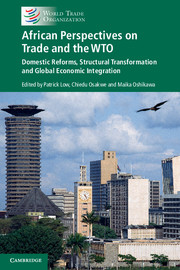 African Perspectives on Trade and the WTO
African Perspectives on Trade and the WTO from Part I - The Future of the Multilateral Trading System: Perspectives from African Policy-Makers and Partners
Published online by Cambridge University Press: 27 October 2016
Morocco’s membership of the GATT and WTO has been part of an overall strategy of the Government of the Kingdom of Morocco, at the instigation of the late King Hassan II, to introduce a package of institutional and socio-economic reforms, which sought mainly to modify and diversify the structure of the national economy, optimize the allocation of its resources and ensure its integration into the world economy. Being a Member of the Multilateral Trading System is also an expression of the government’s wish to integrate more fully into the world economy by anchoring its reforms in the legal primacy of an international agreement, rather than just in domestic legislation, as reaffirmed by the Constitution adopted in 2011. In doing so, Morocco made opening up its economy a firm and irreversible commitment.
Through the WTO and its wide network of free trade agreements, Morocco is moving to the next phase of its trade and investments policies, focusing on value-added exports and world-class infrastructures as well as on renewable energy. Twenty years after Marrakesh, the system still carries value for Morocco and Africa and will certainly be a tool for trade and investments in the next two decades. Africa’s role needs to be strengthened. While Africa’s share in world trade has improved considerably over the past decade, it is difficult to accept that a continent which represents more than the 15 per cent of the world’s population should still account for only 3 per cent of world trade. The legitimate objective that we should probably all be pursuing over the next few decades is matching Africa’s share in world trade with its share in the world’s population.
To save this book to your Kindle, first ensure [email protected] is added to your Approved Personal Document E-mail List under your Personal Document Settings on the Manage Your Content and Devices page of your Amazon account. Then enter the ‘name’ part of your Kindle email address below. Find out more about saving to your Kindle.
Note you can select to save to either the @free.kindle.com or @kindle.com variations. ‘@free.kindle.com’ emails are free but can only be saved to your device when it is connected to wi-fi. ‘@kindle.com’ emails can be delivered even when you are not connected to wi-fi, but note that service fees apply.
Find out more about the Kindle Personal Document Service.
To save content items to your account, please confirm that you agree to abide by our usage policies. If this is the first time you use this feature, you will be asked to authorise Cambridge Core to connect with your account. Find out more about saving content to Dropbox.
To save content items to your account, please confirm that you agree to abide by our usage policies. If this is the first time you use this feature, you will be asked to authorise Cambridge Core to connect with your account. Find out more about saving content to Google Drive.